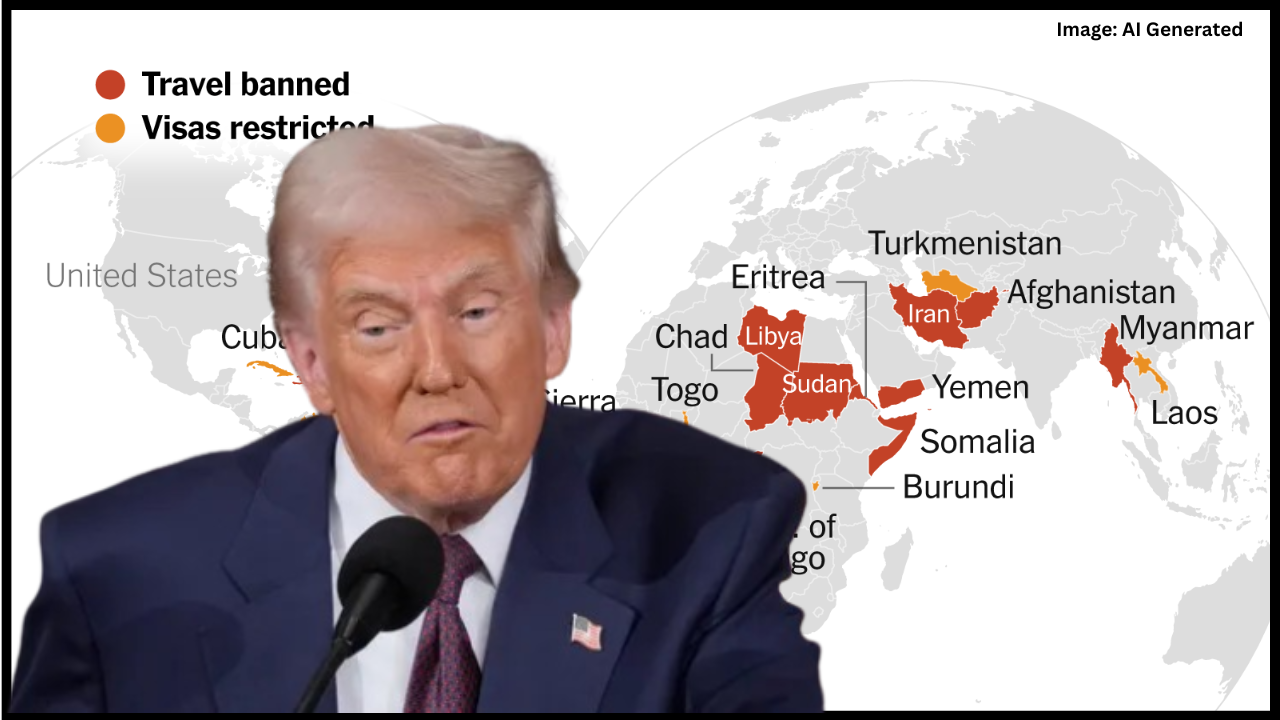On June 4, 2025, U.S. President Donald Trump signed a new travel ban proclamation that takes effect on June 9, 2025. This policy restricts travel and visa issuance for citizens of 12 countries deemed to pose heightened security risks due to insufficient vetting procedures, increased terrorism threats, or visa misuse. Additionally, seven other countries face partial travel restrictions with stricter visa protocols. The announcement has raised widespread concerns across affected nations and has important implications for travelers, immigration lawyers, and global relations. This article explains the new Trump travel ban clearly and comprehensively, breaking down who is affected, what the restrictions entail, exemptions, practical advice, and what professionals and travelers need to know going forward.
Quick Summary
- The new Trump travel ban targets 12 countries with a full U.S. entry ban on most visa categories including tourist, business, student, and immigrant visas.
- An additional 7 countries face partial travel restrictions, involving enhanced security screening and stricter visa issuance processes.
- A wider list of 43 countries was reviewed using a tier system (red, orange, yellow) to classify security risks and potential travel restrictions.
- India is not included in any tier or restriction list, meaning Indian citizens face no new bans or restrictions.
- Important exemptions exist for U.S. green card holders, diplomats, dual nationals, athletes, and certain humanitarian visa categories.
- Travelers and immigration professionals are strongly encouraged to rely on official government resources and stay updated on policy changes.
- The ban is part of the Trump administration’s effort to strengthen national security but has drawn criticism for potential discriminatory impacts.
What Is the New Trump Travel Ban?
The new travel ban is an updated version of previous restrictions implemented by the Trump administration in earlier years. The stated purpose is to enhance U.S. national security by restricting entry of foreign nationals from countries that allegedly have weak visa vetting processes or elevated security risks. According to official sources like Reuters and AP News, the proclamation signed by President Trump on June 4 bans the issuance of most immigrant and nonimmigrant visas for citizens of 12 countries effective June 9, 2025. The ban applies broadly to tourism, business, student, and family-based immigration visas, although exemptions exist.
Countries Fully Banned From U.S. Entry
The 12 countries facing a complete U.S. travel ban are:
- Afghanistan
- Myanmar (Burma)
- Chad
- Republic of the Congo
- Equatorial Guinea
- Eritrea
- Haiti
- Iran
- Libya
- Somalia
- Sudan
- Yemen
Citizens of these countries are barred from entering the U.S. under most visa categories, including tourist visas (B-2), business visas (B-1), student visas (F-1), and immigrant visas for permanent residency. This ban essentially freezes travel and immigration from these countries to the U.S. unless special exemptions apply.
Exemptions to the Full Ban
The ban does not apply indiscriminately. Exemptions include:
- U.S. lawful permanent residents (green card holders) from banned countries may still enter the U.S.
- Dual nationals traveling on passports from countries not subject to the ban. For example, a dual Afghan-French citizen traveling on a French passport is not subject to the Afghan ban.
- Diplomats and government officials traveling on official business.
- Athletes and participants in international events such as the Olympics or FIFA World Cup.
- Special humanitarian visas, including those related to adoption, family reunification, or asylum cases under strict criteria.
These exemptions are designed to balance security with humanitarian and diplomatic needs. However, travelers still face heightened scrutiny and may encounter longer processing times.
Countries Facing Partial Travel Restrictions
In addition to the full bans, seven countries face partial restrictions, meaning that visa applications are still accepted but under more stringent conditions:
- Burundi
- Cuba
- Laos
- Sierra Leone
- Togo
- Turkmenistan
- Venezuela
Partial restrictions include:
- Mandatory in-person visa interviews even if the applicant might otherwise qualify for interview waivers.
- Shortened visa validity periods and limitations on multiple-entry visas.
- Enhanced background and security checks for visa applicants.
- Restrictions on certain visa types depending on diplomatic relations and security assessments.
This approach allows some continued travel while addressing potential risks via tighter controls.
Broader Review and Tier System
A leaked internal memo revealed that the U.S. government evaluated a total of 43 countries for possible travel restrictions based on national security assessments. These countries were classified into three tiers:
- Red Tier: Full travel ban (the 12 countries listed above).
- Orange Tier: Partial restrictions (the 7 countries above).
- Yellow Tier: Countries under a 60-day review period to address security concerns or face possible upgrades in restrictions.
India is notably absent from all tiers, meaning Indian nationals face no new restrictions or bans related to this travel policy update.
Why Was This Travel Ban Implemented?
The Trump administration justifies the ban as a necessary step to protect U.S. national security. They argue that the countries listed either lack effective passport control, have ongoing conflicts or terrorism threats, or have demonstrated poor compliance with U.S. visa protocols. By tightening entry requirements, the administration aims to reduce the risk of admitting individuals who might pose security threats or overstay their visas. However, this policy has faced strong criticism:
- Human rights organizations argue it unfairly targets certain nationalities and religions, creating barriers for legitimate travelers and immigrants.
- Legal experts point out that the ban disrupts family reunification and can negatively affect students, refugees, and asylum seekers.
- Critics also warn about damaging diplomatic relations and the U.S.’s image abroad.
Nonetheless, the administration maintains that the travel ban is essential for safeguarding American citizens.
Practical Advice for Affected Travelers and Immigration Professionals
What Should Travelers Do?
- Check the U.S. Department of State website regularly for the latest updates on visa eligibility and restrictions.
- Contact your nearest U.S. embassy or consulate to confirm visa appointment availability, processing times, and any new documentation requirements.
- If you are a green card holder or dual national, verify your exemption status and carry all required proof during travel.
- Plan trips well in advance, anticipating possible delays or denials in visa processing.
- Stay informed about humanitarian visa options if you fall under special categories such as adoption or asylum.
What Should Immigration Professionals Know?
- Stay current on policy updates and official guidance from U.S. government agencies to advise clients accurately.
- Inform clients from banned or restricted countries about the heightened visa scrutiny and potential delays.
- Prepare clients for additional documentation requests and in-person interviews.
- Monitor ongoing country tier reviews to anticipate future restrictions or removals.
Overall Summary
The 2025 Trump travel ban is a significant update to U.S. immigration policy with broad effects on citizens of 19 countries either fully or partially restricted from entering the U.S. These measures reflect the administration’s focus on national security through more stringent vetting and visa controls. While aiming to protect American interests, the ban also raises complex questions about fairness, humanitarian concerns, and international diplomacy. For travelers and immigration professionals, the key is to stay informed through official channels, understand exemptions, and prepare for enhanced scrutiny. Clear communication, advance planning, and legal guidance will help navigate the complexities introduced by this policy.
Read More
SNAP Benefits May Be Going Up Soon! Full Details Inside
FAQs about Trump Issues New Travel Ban
Q1: Are citizens of all countries on the banned list completely barred from entering the U.S.?
A1: Most visa types for citizens of the 12 fully banned countries are denied, but there are exemptions for green card holders, dual nationals using other passports, diplomats, and special visa categories.
Q2: How can travelers know if their country is under partial restrictions?
A2: Seven countries face partial restrictions with enhanced vetting. Check official U.S. government visa pages or embassy advisories for the latest status.
Q3: Will Indian citizens be affected by this travel ban?
A3: No, India is not on any banned or restricted list and faces no new travel restrictions as of June 2025.
Q4: Can travelers from banned countries apply for humanitarian or special visas?
A4: Some humanitarian visas, like for adoption or asylum, may still be granted under strict guidelines. Consult legal or embassy sources for specifics.
Q5: Where can I find the most reliable updates about the travel ban?
A5: Official websites such as the U.S. Department of State, U.S. Citizenship and Immigration Services (USCIS), and U.S. embassies provide authoritative information.

